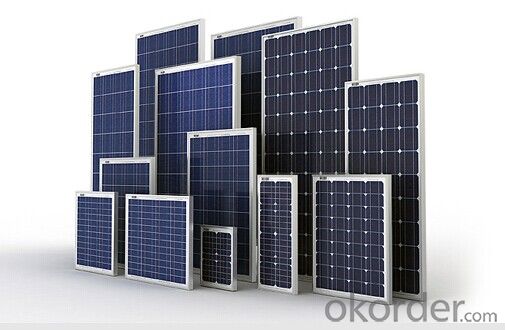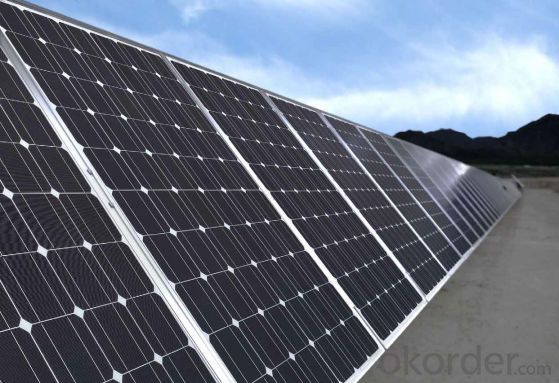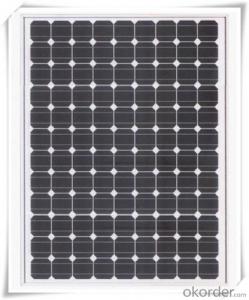160W Monocrystalline Solar Panel with 25 Years Warranty CNBM
- Loading Port:
- Qingdao
- Payment Terms:
- TT OR LC
- Min Order Qty:
- 10 set
- Supply Capability:
- 300000 set/month
OKorder Service Pledge
OKorder Financial Service
You Might Also Like
Monocrystalline Solar Panel with 160W



Monocrystalline Solar Modules
We offers a range of small, medium and large monocrystalline solar modules, designed for a range of requirements.
Specifications:
Tolerance | +/- 3% |
Cell | Monocrystalline silicon solar cells |
N0. of Cells | 72 (12 x 6) |
Dimension of Modules (mm) | 1581 x 809 x 40 |
Weight (kg) | 15.5 |
Limits:
Operating Temperature | -40~+85? |
Storage Temperature | -40~+85? |
Maximum System Voltage | 1000 VDC max. |
Hail Impact | Diameter of 28mm with impact speed of 86km/h |
Temperature and Coefficients:
NOCT | 48C+/-2? |
Voltage temperature coefficient (%/K) | -0.34 |
Current temperature coefficient (%/K) | 0.09 |
Power temperature coefficient (%/K) | -0.37 |
Characteristics:
Model: | SGM-160D | SGM-165D | SGM-170D |
Max-power voltage Vmp (V) | 34.5 | 35.4 | 35.8 |
Max-power current Imp (A) | 4.64 | 4.66 | 4.75 |
Open-circuit voltage Voc (V) | 41.75 | 43.6 | 43.32 |
Short-Circuit Current Isc (A) | 5.32 | 5.08 | 5.38 |
Max-power Pm(W) | 160 | 165 | 170 |
Model: | SGM-175D | SGM-180D | SGM-185D |
Max-power voltage Vmp (V) | 36.1 | 36.2 | 36.2 |
Max-power current Imp (A) | 4.85 | 4.97 | 5.11 |
Open-circuit voltage Voc (V) | 43.68 | 43.8 | 44.8 |
Short-Circuit Current Isc (A) | 5.49 | 5.48 | 5.51 |
Max-power Pm(W) | 175 | 180 | 185 |
STC: Irradiance 1000W/m2, Module temperature 25?, AM=1.5
Monocrystalline Solar Panels Specifications Range
Maximum Power (Pm) | Dimension | Weight | Operating Voltage (Vmp) | Operating Current (Imp) | Open Circuit Voltage (Voc) | Short Circuit Current (Isc) |
3W | 158x241x25mm | 0.5kg | 8.5V | 0.36A | 10.5V | 0.4A |
4W | 308x166x25mm | 0.77kg | 8.5V | 0.47A | 10.5V | 0.54A |
4W | 308.x166x25mm | 0.77kg | 16.8V | 0.24A | 21V | 0.27A |
5W | 296x215x25mm | 0.3kg | 16.8V | 0.48a | 21V | 0.54A |
10W | 286x406x25mm | 1.5kg | 16.8V | 0.59A | 21V | 0.66A |
12W | 286x406x25mm | 1.5kg | 16.8V | 0.71A | 21V | 0.8A |
14W | 286x541x25mm | 2kg | 16.8V | 0.83A | 21V | 0.96A |
16W | 286x541x25mm | 2kg | 17.2V | 0.93A | 21.5V | 0.99A |
18W | 296x541x25mm | 2.4kg | 18.8V | 1.07A | 21V | 1.2A |
20W | 296x641x25mm | 2.4kg | 17.2V | 1.15A | 21.5V | 1.24A |
24W | 541x451x25mm | 3.15kg | 16.8V | 1.14A | 21V | 1.56A |
26W | 541x451x25mm | 3.15kg | 17.2V | 1.51A | 21.5V | 1.63A |
30W | 296x966x25mm | 3.85kg | 16.8V | 1.78A | 21V | 2.03A |
36W | 541x641x35mm | 4.7kg | 16.8V | 2.14a | 21V | 2.4A |
40W | 541x641x35mm | 4.7kg | 17.2V | 2.33A | 21.5V | 2.5A |
55W | 1057x457x35mm | 6.6kg | 17.6V | 3.12A | 21.6V | 3.3A |
70W | 546x1196x35mm | 8.5kg | 16.8V | 4.15A | 21V | 4.7A |
75W | 546x1196x35mm | 8.5kg | 17.2V | 4.36A | 21.5V | 4.8A |
80W | 546x1196x35mm | 8.5kg | 17.6V | 4.55A | 21.6V | 4.9A |
110W | 1066x811x40mm | 11.8kg | 17.6V | 6.25A | 21.6V | 6.6A |
150W | 1066x811x40mm | 14kg | 34.4V | 4.36A | 43.2V | 4.7A |
- Q:Can solar panels be installed in areas with frequent power outages?
- Yes, solar panels can be installed in areas with frequent power outages. In fact, they can be a great solution to overcome the challenges of unreliable power grids. Solar panels generate electricity from sunlight, which means they can operate independently of the grid during power outages. By storing excess energy in batteries, solar panels can provide a reliable and uninterrupted power supply, even in areas prone to frequent outages.
- Q:Got a small project here in a remote location. There is to be a 2 volt deep cycle battery, the equipment to be powered from battery and solar panel to charge battery. The 2 volt battery puts out 55 AH. the max constant power draw from the equipment to be powered is 7.9 watts. Will a 30 watt panel at 2 volts be enough to run this system during sunlight and charge the battery for the equipment to run overnight?And, at 55 AH, how long can I keep a constant draw of 7.9 watts without a recharge?Thanks to all the input!
- o work out the wattage correctly, the panel needs to be sized according to how much power you are going to use. (Later on you're going to need a bit of info on each electrical item you need to be solar powered).
- Q:Just curious.
- Solar panels are built with light-sensitive panels. These panels soak up the energy from the sun's light. This energy is changed to electric power. This power is stored in batteries to use whenever / wherever it is needed.
- Q:how the energy of load connected to solar PV measure.?Want too the basic idea about it.The role of current flowing thrugh the load?Can u explain with example..can explain simply?Im not an electrical student so explain very basics
- A solar panel is made up of solar cells. Each cell produces about 0.5 to 0.6 volts. Cells are connected in series, like the batteries in a flashlight. Enough cells are placed in series to produce the desired voltage. Cells produce very little current, so many strings of cells are connected in parallel to produce sufficient current. The output is direct current (DC), like that from a battery. A home solar system needs alternating current (AC), so an inverter is used to change from DC to AC. Some systems have batteries for backup power. In these some of the DC output is used to keep the batteries charged. Systems are measured in kilowatts. System sizes are chosen to meet the demands for electricity. My system has a 6 kilowatt (kW) rating. The true output is more like 4. Now that you know this much you can Google SOLAR SYSTEMS to learn more.
- Q:Are there any noise concerns with solar panels?
- No, solar panels do not produce any noise as they generate electricity from sunlight without any moving parts.
- Q:i really love the idea of solar and want to start out small, so i'm new to this.I plan on getting an 85w panel to charge my laptop. what other equipment is needed to accomplish this?would i need to get a battery or does the solar panel hook directly to the laptop. Does one end just lead to a conventional outlet similar to a wall outlet?could someone please give me a detailed explanation with options about this? i would greatly appreciate it.
- humm..... .need HUGE solar panel (alot) 2. wires 3. aligato clips . put the panels on the roof 2. use the aligator clip to clip the wire from the panel to the bars of the pluger of the comp. charger 3.tada mark me best:)
- Q:Can solar panels be installed in areas with high humidity?
- Yes, solar panels can be installed in areas with high humidity. While humidity can affect the performance of solar panels to some extent, it does not prevent their installation or significantly diminish their overall effectiveness.
- Q:Can solar panels power my entire home?
- Yes, solar panels have the potential to power your entire home, depending on various factors such as the size of your solar panel system, the amount of sunlight in your area, your energy consumption patterns, and the efficiency of your appliances. It is important to consult with a solar professional to assess your specific energy needs and design a system that can meet your requirements.
- Q:Can solar panels be used in multi-story buildings?
- Yes, solar panels can be used in multi-story buildings. They can be installed on the rooftops or facades of these buildings to harness solar energy and generate electricity. Additionally, advancements in solar panel technology have made it possible to integrate them into building materials, such as windows or cladding, allowing for even more flexibility in their use in multi-story structures.
- Q:Can solar panels be installed on schools or educational institutions?
- Yes, solar panels can be installed on schools or educational institutions. In fact, many schools and educational institutions have already embraced solar energy as a sustainable and cost-effective solution. Installing solar panels not only helps reduce carbon emissions but also provides educational opportunities for students to learn about renewable energy and sustainability. Additionally, schools can benefit from reduced energy costs and potentially generate revenue by selling excess energy back to the grid.
1. Manufacturer Overview |
|
|---|---|
| Location | |
| Year Established | |
| Annual Output Value | |
| Main Markets | |
| Company Certifications | |
2. Manufacturer Certificates |
|
|---|---|
| a) Certification Name | |
| Range | |
| Reference | |
| Validity Period | |
3. Manufacturer Capability |
|
|---|---|
| a)Trade Capacity | |
| Nearest Port | |
| Export Percentage | |
| No.of Employees in Trade Department | |
| Language Spoken: | |
| b)Factory Information | |
| Factory Size: | |
| No. of Production Lines | |
| Contract Manufacturing | |
| Product Price Range | |
Send your message to us
160W Monocrystalline Solar Panel with 25 Years Warranty CNBM
- Loading Port:
- Qingdao
- Payment Terms:
- TT OR LC
- Min Order Qty:
- 10 set
- Supply Capability:
- 300000 set/month
OKorder Service Pledge
OKorder Financial Service
Similar products
New products
Hot products
Related keywords



























